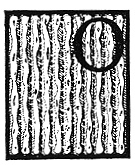
Sacred Texts Judaism Index Previous Next
Buy this Book at Amazon.com


The Union Haggadah, ed. by The Central Council of American Rabbis [1923], at sacred-texts.com
 |
A large platter containing Seder symbols:
b. The roasted shank-bone (of a lamb).
c. A roasted egg.
Also a piece of horseradish, a bit of haroses, and a spray of parsley.
Besides these, there are placed on the table for the company:
2. A dish of haroses.
3. Parsley or watercress.
4. A dish of salt water.
The meal served during the Seder follows the form of a banquet of olden times. Hence the reference, in the Hebrew texts of the Four Questions, to the custom of reclining on the left side—a position assumed by free men. Preserving this custom, many households still provide a large cushioned armchair for the person conducting the Seder.
The table is usually spread with the best of the family's china and silverware, and adorned with flowers, in keeping with the festive spirit.